The Nassington Walk Part 2
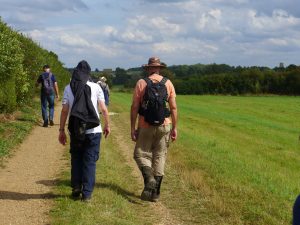 Photographic inputs by Jonathan Brigland. Commentary by Ethelblue the Untidy.
Photographic inputs by Jonathan Brigland. Commentary by Ethelblue the Untidy.
It is perhaps fair to say that not much has happened in Nassington after the visit of King Cnut in 1017 (a bit late for breakfast but rather early for elevensies) until Peterborough Ramblers came along and inspected what was left of the locale.
In fact the population 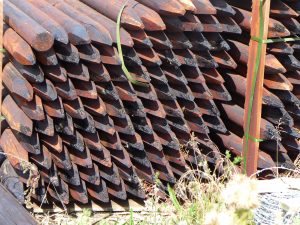 of the kingdom as a whole during this period of has risen by just four percent whereas within this zone it has expanded massively – by no less than 23 percent in the space of just ten years. This compares with the annual growth of the UK of £5.20p
of the kingdom as a whole during this period of has risen by just four percent whereas within this zone it has expanded massively – by no less than 23 percent in the space of just ten years. This compares with the annual growth of the UK of £5.20p
So what has been going on in Nassington to encourage such a development? We decided to find out!
In fact one of the main reasons for the growth in the local population has been the evolution of the giant pencil factory – one of whose storage units you can see here. These giants
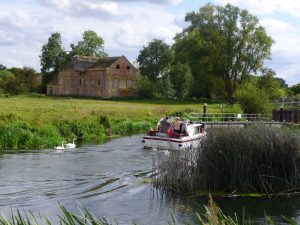 are exported along the River Nene until they reach the Mouth of the Wash, and become toothpaste in a process still protected by ancient trading rights and Letters Patent handed out by the Great Seal resident in the river close to where this boat is seen.
are exported along the River Nene until they reach the Mouth of the Wash, and become toothpaste in a process still protected by ancient trading rights and Letters Patent handed out by the Great Seal resident in the river close to where this boat is seen.
You will also see in this picture two pilot swans which are only known to exist on the Nene but are much sought after by those from Foreign Parts
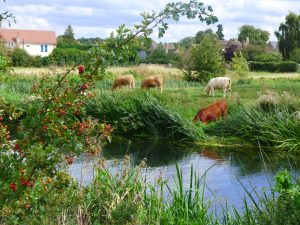 Equally unusual but found within the river’s environs are the headless cattle and you can see one centre right and down a bit in this picture. They were brought to England by Ethelred the Untidy in 1245 – or “just before lunch” as we tend to say these days. Also of interest is the house top left.
Equally unusual but found within the river’s environs are the headless cattle and you can see one centre right and down a bit in this picture. They were brought to England by Ethelred the Untidy in 1245 – or “just before lunch” as we tend to say these days. Also of interest is the house top left.
Boats still motor up and down the river at this point travelling in what nautical folk such as I call “thither and yon”.
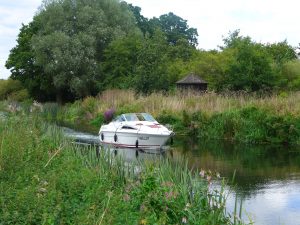 This phrase dates back to last week when I made it up.
This phrase dates back to last week when I made it up.
In this next picture you can witness the local speed copse. The term “speed copse” is one of those that is of course often misunderstood, meaning as it does a small group of trees on the march, as opposed to a large group of trees travelling in April, which in these parts is a lot more common.
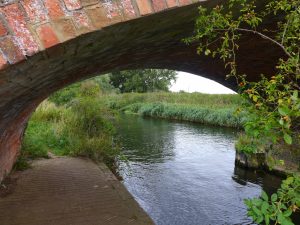 The destination of such trees has long been a mystery but was solved on one of our earlier walks, and indeed a Radio 4 documentary on the subject is being broadcast on Radio One yesterday.
The destination of such trees has long been a mystery but was solved on one of our earlier walks, and indeed a Radio 4 documentary on the subject is being broadcast on Radio One yesterday.
Here we can see how the naturally growing bricktrees combine knowingly to arch across the river and thus nature once again outwit the horned beast and everyone can eat their lunch in peace. Or in pieces if they don’t wish to.
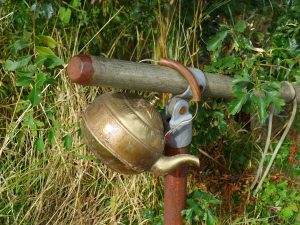 Of course lunch would be as nought were it not for a pint of tea and here we see the magical golden teapot of Nassington manufactured in the days of Breakfast Uprising, which saw the occupation of the lands hereabout by the Great Seal, of which we should perhaps mention as little possible. And thus our journey continued with enthusiasm and elegance until such moments as the cry of,
Of course lunch would be as nought were it not for a pint of tea and here we see the magical golden teapot of Nassington manufactured in the days of Breakfast Uprising, which saw the occupation of the lands hereabout by the Great Seal, of which we should perhaps mention as little possible. And thus our journey continued with enthusiasm and elegance until such moments as the cry of, 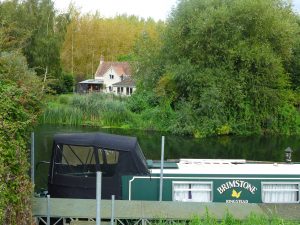 “we’re back where we started well stone the crows and no mistake” arises from the assembled gathering and one and all raise a merry cheer for our glorious leader and each wishes the other well until we meet again either next week or down the pub a few minutes later.
“we’re back where we started well stone the crows and no mistake” arises from the assembled gathering and one and all raise a merry cheer for our glorious leader and each wishes the other well until we meet again either next week or down the pub a few minutes later.
As with everything it is of course a matter choice. The tale of The Nassington Walk Part the First can be found here but if you go there you will be reading this backwards which is against local custom.